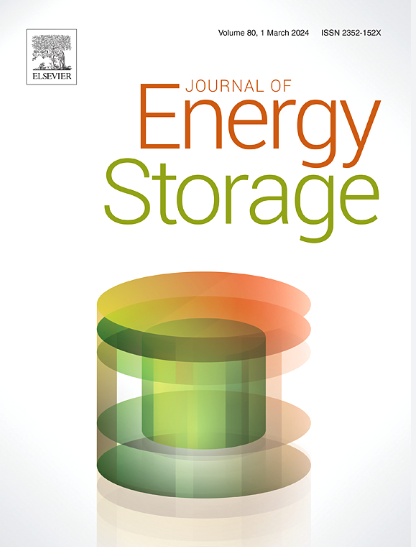非均匀温度分布条件下锂离子电池的性能与老化
IF 8.9
2区 工程技术
Q1 ENERGY & FUELS
引用次数: 0
摘要
大尺寸锂离子电池或组件/电池组中电池之间的温度分布不均匀可能导致电流分布不均匀,从而导致局部老化差异,并可能导致组件的整体老化(容量衰减和阻抗上升)加快。为了研究这一效应,将LiNi1/3Mn1/3Co1/3O2/石墨锂离子袋状电池分别在32、36和40℃下进行单电池和并联循环,分别呈现均匀和不均匀的温度分布。结果表明,在较高的循环速率和较窄的充电状态范围内,电流分布变得不均匀。在3C速率下,非均匀温度循环的时效与最大均匀温度下的时效相似,而在1C速率下,非均匀时效遵循平均温度下的趋势。在3C下循环的电池的性能衰减主要是由40°C下的电池驱动的,其容量损失比单独循环的电池多30%。在设计快速充电应用和高功率应用(如电动汽车或固定存储中的频率调节)的循环寿命和可靠性时,这导致了额外的考虑。本文章由计算机程序翻译,如有差异,请以英文原文为准。

Performance and aging of a lithium-ion battery in a non-uniform temperature distribution condition
Inhomogeneous temperature distribution in a large-format lithium-ion cell or between cells in a module/pack may cause a non-uniform current distribution, causing a local difference in aging, and potentially faster global aging (capacity fade and impedance rise) of the module. To study this effect, LiNi1/3Mn1/3Co1/3O2/graphite lithium-ion pouch cells were cycled at 32, 36, and 40 °C as single cells and in parallel connection, representing uniform and non-uniform temperature distributions. The results show that the current distribution becomes less uniform after cycling at a higher rate and in a narrower state-of-charge range. Cycling with non-uniform temperature at 3C rate results in aging similar to that at the maximum uniform temperature, while at 1C rate the non-uniform aging follows the trend at the average temperature. The performance decay of the cells cycled at 3C is mainly driven by the cell at 40 °C which shows 30 % more capacity loss than the corresponding cell cycled singularly. This leads to additional considerations when designing for cycle life and reliability in fast charging applications and high-power applications such as in electric vehicles or frequency regulation in stationary storage.
求助全文
通过发布文献求助,成功后即可免费获取论文全文。
去求助
来源期刊

Journal of energy storage
Energy-Renewable Energy, Sustainability and the Environment
CiteScore
11.80
自引率
24.50%
发文量
2262
审稿时长
69 days
期刊介绍:
Journal of energy storage focusses on all aspects of energy storage, in particular systems integration, electric grid integration, modelling and analysis, novel energy storage technologies, sizing and management strategies, business models for operation of storage systems and energy storage developments worldwide.
 求助内容:
求助内容: 应助结果提醒方式:
应助结果提醒方式:


